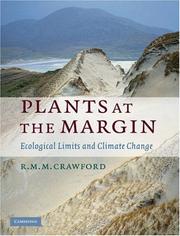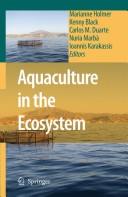| Listing 1 - 10 of 5272 | << page >> |
Sort by
|

ISBN: 9780521623094 052162309X 9780511754906 9780521626538 9780511392061 0511392060 9780511389290 0511389299 0511394152 9780511394157 9780511394805 0511394802 0511754906 9786611751036 6611751033 1107173051 1281751030 051139084X 0511393377 0521626536 9781107173057 9781281751034 9780511393372 Year: 2008 Publisher: Cambridge New York Cambridge University Press
Abstract | Keywords | Export | Availability | Bookmark
 Loading...
Loading...Choose an application
- Reference Manager
- EndNote
- RefWorks (Direct export to RefWorks)
Margins are by their very nature environmentally unstable - does it therefore follow that plant populations adapted for life in such areas will prove to be pre-adapted to withstand the changes that may be brought about by a warmer world? Biogeography, demography, reproductive biology, physiology and genetics all provide cogent explanations as to why limits occur where they do, and the purpose of this book is to bring together these different avenues of enquiry. Crawford's numerous beautiful illustrations of plants in their natural habitats remind us that the environment remains essential to our understanding of plants and their function. This book is suited to students, researchers and anyone with an interest in the impact of climate change on our world.
Plant ecology. Plant sociology --- Meteorology. Climatology --- ECO Ecology --- marginal areas --- Arctic regions --- adaptative strategies --- climatic changes --- coastal regions --- Vegetation and climate. --- Climatic changes --- Changes, Climatic --- Changes in climate --- Climate change --- Climate change science --- Climate changes --- Climate variations --- Climatic change --- Climatic fluctuations --- Climatic variations --- Global climate changes --- Global climatic changes --- Climatology --- Climate change mitigation --- Teleconnections (Climatology) --- Plant bioclimatology --- Plant biometeorology --- Plants --- Plants and climate --- Bioclimatology --- Environmental aspects. --- Environmental aspects --- Climatic factors --- Effect of climate on --- Effect of climatic changes on --- Climatic changes. --- Global environmental change

ISBN: 9780511485435 9780521862363 9780521188722 0511409257 9780511409790 0511409796 0511407890 9780511407895 9780511409257 0511485433 9786611716943 6611716947 0521862361 1107178037 1281716944 0511407157 0511408684 0521188725 Year: 2008 Publisher: Cambridge, UK New York Cambridge University Press
Abstract | Keywords | Export | Availability | Bookmark
 Loading...
Loading...Choose an application
- Reference Manager
- EndNote
- RefWorks (Direct export to RefWorks)
For centuries, poets have been ensnared - as one of their number, Andrew Marvell put it - by the beauty of flowers. Then, from the middle of the eighteenth century onward, that enjoyment was enriched by a surge of popular interest in botany. Besides exploring the relationship between poetic and scientific responses to the green world within the context of humanity's changing concepts of its own place in the ecosphere, Molly Mahood considers the part that flowering plants played in the daily lives and therefore in the literary work of a number of writers who could all be called poet-botanists: Erasmus Darwin, George Crabbe, John Clare, John Ruskin and D. H. Lawrence. A concluding chapter looks closely at the meanings, old or new, that plants retained or obtained in the violent twentieth century.
Botany in literature --- English poetry --- Nature in literature --- Perception in literature --- Philosophy of nature in literature --- Nature in poetry --- History and criticism --- Clare, John, --- Crabbe, George, --- Darwin, Erasmus, --- Lawrence, D. H. --- Ruskin, John --- Lawrence, David Herbert --- Davison, Lawrence H. --- Lorensŭ --- Lorensŭ, D. H. --- Lourens, D. G. --- Lorenss, D. H. --- Lorens, Deĭvid Gerbert --- Lārensu, Ḍi. Ec. --- Lourens, Dėvid Gerbert --- לאורנס, ד. ה. --- לאורענס --- לורנס, ד״ה --- לורנס, ד.ה., --- לורנס, ד.ה..., --- Darvin, Ėrazm, --- Crabbe, --- Knowledge --- Botany. --- Botany in literature. --- Nature in literature. --- Perception in literature. --- Philosophy of nature in literature. --- History and criticism. --- Ruskin, John, --- Darwin, Erasmus --- Darwin, Erasme --- Rëskin, Dzhon, --- Ruskin, --- Ruskin, J. --- Rŏsŭkʻin, --- Modern painters, Author of, --- Author of Modern painters, --- Graduate of Oxford, --- Rasukin, Jon, --- ラスキンジョン, --- Arts and Humanities --- Literature --- Lawrence, D.H.
Book
Year: 2008 Publisher: Cambridge Cambridge University Press
Abstract | Keywords | Export | Availability | Bookmark
 Loading...
Loading...Choose an application
- Reference Manager
- EndNote
- RefWorks (Direct export to RefWorks)
Book
ISBN: 3805586531 9783805586535 1283153386 380558654X 9786613153388 Year: 2008 Publisher: S. Karger
Abstract | Keywords | Export | Availability | Bookmark
 Loading...
Loading...Choose an application
- Reference Manager
- EndNote
- RefWorks (Direct export to RefWorks)
Genetic disorders. --- Noonan Syndrome --- Ras oncogenes. --- Ras proteins. --- Signal Transduction. --- Ras Proteins --- Genetics. --- Physiopathology.
Book
ISBN: 9783832277864 3832277862 Year: 2008 Publisher: Berlin Shaker Verlag
Abstract | Keywords | Export | Availability | Bookmark
 Loading...
Loading...Choose an application
- Reference Manager
- EndNote
- RefWorks (Direct export to RefWorks)
Book
ISBN: 1282848844 9786612848841 1441675345 600002875X Year: 2008 Publisher: Mumbai : Himalaya Books Pvt. Ltd.,
Abstract | Keywords | Export | Availability | Bookmark
 Loading...
Loading...Choose an application
- Reference Manager
- EndNote
- RefWorks (Direct export to RefWorks)
Global warming is a current and burning topic, today. To comprehend, it is: the gradual increase in the overall temperature of the earth`s atmosphere, due to increased level of carbon dioxide and other pollutants.` Extreme weather events, rise in the sea level and a plethora of diseases are some of the serious concerns, which have drawn attention of policy-makers and scientists. It has a number of negative effects on, say, natural systems and creatures, such as butterflies, alpine herbs, life cycle of birds and plantation, etc. Given its harmful impacts, initiatives have been taken, both...
Book
ISBN: 1281180416 9786611180416 0387755101 0387755098 0387922911 Year: 2008 Publisher: New York : Springer,
Abstract | Keywords | Export | Availability | Bookmark
 Loading...
Loading...Choose an application
- Reference Manager
- EndNote
- RefWorks (Direct export to RefWorks)
The future of Earth’s ecosystems is increasingly influenced by the pace and patterns of urbanization. One of the greatest challenges for natural and social scientists is to understand how urbanizing regions evolve through the complex interactions between humans and ecological processes. Questions and methods of inquiry specific to our traditional disciplinary domains yield partial views that reflect different epistemologies and understandings of the world. In order to achieve the level of synthesis required to see the urban ecosystem as a whole we must change the way we pose questions and search for answers. Cities are the result of human and ecological processes occurring simultaneously in time and in space and the legacy of the simultaneous processes of the past. Urban ecology is the study of the co-evolution of human-ecological systems. Scholars of both urban systems and ecology must challenge the assumptions and world views within their disciplines and work towards a hybrid theory that builds on multiple world views. The synthesis of research findings provided in this book is a first step towards articulating the challenge for scholars of urban ecosystems; it leads the way toward the integration we must achieve if we are to better understand and solve emerging issues in urban ecosystems. Marina Alberti is Associate Professor in the Department of Urban Design and Planning and Director of the Urban Ecology Research Lab (http://www.urbaneco.washington.edu/) at the University of Washington in Seattle, Washington.
Urban ecology (Sociology) --- Urban ecology (Biology) --- Cities and towns --- City ecology (Biology) --- Ecology --- Urban ecology --- Urban environment --- Social ecology --- Sociology, Urban --- Environmental aspects --- Urban Ecology. --- Environmental sciences. --- Environment, general. --- Environmental science --- Science --- Urban ecology (Biology). --- Environment. --- Balance of nature --- Biology --- Bionomics --- Ecological processes --- Ecological science --- Ecological sciences --- Environment --- Environmental biology --- Oecology --- Environmental sciences --- Population biology

ISBN: 1281216305 9786611216306 1402068107 1402068093 9048177324 Year: 2008 Publisher: [Dordrecht] : Springer,
Abstract | Keywords | Export | Availability | Bookmark
 Loading...
Loading...Choose an application
- Reference Manager
- EndNote
- RefWorks (Direct export to RefWorks)
The global expansion of aquaculture production and its future role as a food supplier to human society has environmental, social and economic limitations, affecting marine ecosystems and socio-economic scales from local to global. The expansion is closely linked with human health requirements and societal needs for various goods and services provided by marine ecosystems. This book provides a scientific forecast of the development in aquaculture with a focus on the environmental, technological, social and economic constraints that need to be resolved to ensure sustainable development of the industry and allow the industry to be able to feed healthy seafood products to the future generations. The chapters included discuss the most critical bottlenecks of the development encompassing subjects of understanding the environmental impacts, the current state-of-art in monitoring programs and in coastal zone management, the important interactions between wild and cultured organisms including release of non-native species into the wild, the current trends within the development of aquafeeds along with human health aspects as well as the political, socio-economic and economic trends within the industry including a chapter on approaches taken by Non Governmental Organisations (NGOs) to aquaculture. Finally the last chapter provides different future scenarios of the industry based on the identified bottlenecks. The contributions to this book were supported by the EC-funded SAMI project.
Aquaculture --- Sustainable aquaculture. --- Environmental aspects. --- Social aspects. --- Aquiculture --- Agriculture --- Sustainable agriculture --- Wildlife management. --- Animal ecology. --- Agriculture. --- Aquatic biology. --- Ecology. --- Environmental management. --- Fish & Wildlife Biology & Management. --- Animal Ecology. --- Freshwater & Marine Ecology. --- Environmental Management. --- Environmental stewardship --- Stewardship, Environmental --- Environmental sciences --- Management --- Balance of nature --- Biology --- Bionomics --- Ecological processes --- Ecological science --- Ecological sciences --- Environment --- Environmental biology --- Oecology --- Population biology --- Hydrobiology --- Water biology --- Aquatic sciences --- Farming --- Husbandry --- Industrial arts --- Life sciences --- Food supply --- Land use, Rural --- Animals --- Zoology --- Ecology --- Animal populations --- Game management --- Management, Game --- Management, Wildlife --- Plant populations --- Wildlife resources --- Natural resources --- Wildlife conservation --- Wildlife. --- Fish. --- Aquatic ecology . --- Ecology . --- Aquatic biology --- Fish --- Pisces --- Aquatic animals --- Vertebrates --- Fisheries --- Fishing --- Ichthyology
Book
ISBN: 1281861456 9786611861452 1402084609 1402084617 9400794975 Year: 2008 Publisher: Dordrecht ; New York : Springer,
Abstract | Keywords | Export | Availability | Bookmark
 Loading...
Loading...Choose an application
- Reference Manager
- EndNote
- RefWorks (Direct export to RefWorks)
Deep-water coral reefs are found along large sections of the outer continental shelves and slopes of Europe, from North Cape to the Gulf of Cadiz, and because they also occur along the Atlantic seaboard of USA, the Gulf of Mexico, off Brazil, in the Mediterranean, and off New Zealand, they are currently being targeted by international groups of marine scientists. They have become popular and opportune deep-water research targets because they offer exciting frontier exploration, combined with a whole plethora of modern scientific methods, such as deep-sea drilling, sampling, remote control surveying and documentation. Furthermore they represent timely opportunities for further developments within the application of geochemistry, stable isotope research, bacterial sciences, including DNA-sequestering, and medical research (search for bioactive compounds). The Integrated Ocean Drilling Program (IODP) has arranged a deep-sea scientific drilling campaign on giant carbonate banks off Ireland. Because the reefs currently defy traditional marine-ecological theories, they represent future research opportunities and will enjoy scientific scrutiny for many years to come.
Deep sea corals. --- Coral reefs and islands. --- Marine biodiversity. --- Diversity, Marine biological --- Marine biological diversity --- Aquatic biodiversity --- Atolls --- Coral atolls --- Coral islands --- Reefs, Coral --- Islands --- Cold-water corals --- Deep corals --- Deep-water corals --- Structure-forming deep corals --- Anthozoa --- Deep-sea animals --- Hydrozoa --- Aquatic biology. --- Geology. --- Animal ecology. --- Oceanography. --- Freshwater & Marine Ecology. --- Animal Ecology. --- Oceanography, Physical --- Oceanology --- Physical oceanography --- Thalassography --- Earth sciences --- Marine sciences --- Ocean --- Animals --- Zoology --- Ecology --- Geognosy --- Geoscience --- Natural history --- Hydrobiology --- Water biology --- Aquatic sciences --- Biology --- Aquatic ecology . --- Aquatic biology
Book
ISBN: 1281512583 9786611512583 1402085311 1402085303 9400789467 Year: 2008 Publisher: Dordrecht ; London : Springer,
Abstract | Keywords | Export | Availability | Bookmark
 Loading...
Loading...Choose an application
- Reference Manager
- EndNote
- RefWorks (Direct export to RefWorks)
Atmospheric ice takes a wide range of fascinating forms, all beautiful in their own ways but many posing severe risk to the security of overhead networks for electric power, communications and other systems. This comprehensive book documents the fundamentals of atmospheric icing and surveys the state of the art in eight chapters, each written by a team of experienced and internationally renowned experts. The treatment is detailed and richly illustrated. The presentation follows a logical sequence, starting with the icing climate and meteorological conditions, proceeding through development of observations and models of accretion and release of ice and heavy snow, then considering static and dynamic mechanical loads, the effects of ice and snow on electrical insulation, de-icing, ice prevention and mitigation methods. The statistical analysis of icing data and the mathematical and numerical modelling support appropriate mechanical and electrical design processes for icing conditions on overhead lines. Technical specialists, researchers and students in engineering and environmental science will all find value throughout the text.
Electric lines --- Ice mechanics. --- Icing (Meteorology) --- Ice prevention. --- Accretion, Ice --- Ice accretion --- Meteorology --- Freezing precipitation --- Ice --- Mechanics --- Ice prevention and control --- Mechanical properties --- Civil engineering. --- Environmental sciences. --- Computer simulation. --- Energy Systems. --- Civil Engineering. --- Atmospheric Sciences. --- Math. Appl. in Environmental Science. --- Simulation and Modeling. --- Energy, general. --- Computer modeling --- Computer models --- Modeling, Computer --- Models, Computer --- Simulation, Computer --- Electromechanical analogies --- Mathematical models --- Simulation methods --- Model-integrated computing --- Environmental science --- Science --- Engineering --- Public works --- Energy systems. --- Atmospheric sciences. --- Energy. --- Atmospheric sciences --- Earth sciences --- Atmosphere
| Listing 1 - 10 of 5272 | << page >> |
Sort by
|

 Search
Search Feedback
Feedback About UniCat
About UniCat  Help
Help News
News